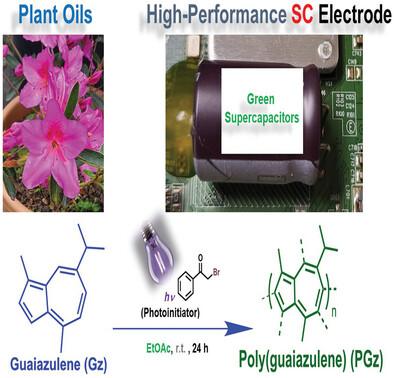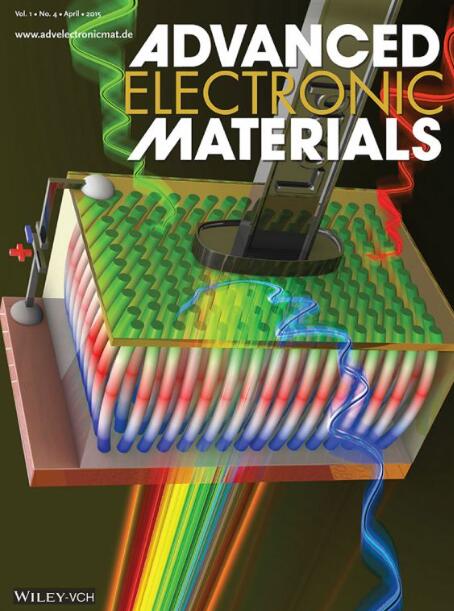From Plant Oils to High-Performance Supercapacitor Electrode: Poly(guaiazulene) via Photopolymerization
IF 5.3
2区 材料科学
Q2 MATERIALS SCIENCE, MULTIDISCIPLINARY
引用次数: 0
Abstract
Due to the increasing global demand for electrical energy, the fabrication of advanced energy storage devices, such as supercapacitors (SCs), with outstanding performance is of paramount importance. Herein, the facile light-induced synthesis of a conjugated conductive polymer, namely, poly(guaiazulene) (PGz) is reported on, using a naturally available, low-cost monomer, guaiazulene (Gz). PGz and PGz_rGO (obtained by combining PGz with reduced graphene oxide (rGO)) exhibited high-performance supercapacitor (SC) electrode properties, including remarkable specific capacitance (52.75 F g−1 at 0.24 A g−1 and 258.6 F g−1 at 5.00 A g−1, respectively), excellent cycling stability (97.1% and 94.0% stability after 5000 cycles), high power density (95.5 and 2118.8 W kg−1), and, most importantly, high energy density (5.81 and 30.57 Wh kg−1). These superior features are attributed to the hierarchical porous nature and high electrical/ionic conductivities of the photochemically obtained PGz. Contrary to previous techniques that require harsh reaction conditions, such as carbonization and coupling reactions, the reported photopolymerization involves solely the irradiation of an ethyl acetate solution of a Gz-organic photoinitiator (2-bromoacetophenone) mixture. The photochemical synthesis described here provides a powerful method to produce a sustainable and high-performance SC electrode material, offering a great alternative to commercial SCs.

从植物油到高性能超级电容器电极:通过光聚合反应制备聚愈创木烯
由于全球对电能的需求日益增长,制造性能卓越的先进储能设备(如超级电容器)至关重要。本文报告了利用一种天然、低成本的单体--愈创木酚(Gz),在光诱导下轻松合成共轭导电聚合物--聚(愈创木酚)(PGz)的过程。PGz 和 PGz_rGO(通过将 PGz 与还原氧化石墨烯 (rGO) 结合获得)表现出高性能的超级电容器 (SC) 电极特性,包括显著的比电容(0.24 A g-1 时为 52.75 F g-1 和 5.00 A g-1 时为 258.6 F g-1 at 5.00 A g-1)、优异的循环稳定性(5000 次循环后的稳定性分别为 97.1% 和 94.0%)、高功率密度(95.5 W kg-1 和 2118.8 W kg-1),以及最重要的高能量密度(5.81 Wh kg-1 和 30.57 Wh kg-1)。这些优异特性归功于光化学方法获得的 PGz 的分层多孔性和高导电性/离子导电性。与以往需要苛刻反应条件(如碳化和偶联反应)的技术不同,所报道的光聚合反应仅涉及对 Gz 有机光引发剂(2-溴苯乙酮)混合物的乙酸乙酯溶液进行辐照。本文所描述的光化学合成为生产可持续的高性能 SC 电极材料提供了一种强有力的方法,为商业 SC 提供了一种很好的替代品。
本文章由计算机程序翻译,如有差异,请以英文原文为准。
求助全文
约1分钟内获得全文
求助全文
来源期刊

Advanced Electronic Materials
NANOSCIENCE & NANOTECHNOLOGYMATERIALS SCIE-MATERIALS SCIENCE, MULTIDISCIPLINARY
CiteScore
11.00
自引率
3.20%
发文量
433
期刊介绍:
Advanced Electronic Materials is an interdisciplinary forum for peer-reviewed, high-quality, high-impact research in the fields of materials science, physics, and engineering of electronic and magnetic materials. It includes research on physics and physical properties of electronic and magnetic materials, spintronics, electronics, device physics and engineering, micro- and nano-electromechanical systems, and organic electronics, in addition to fundamental research.
 求助内容:
求助内容: 应助结果提醒方式:
应助结果提醒方式:


